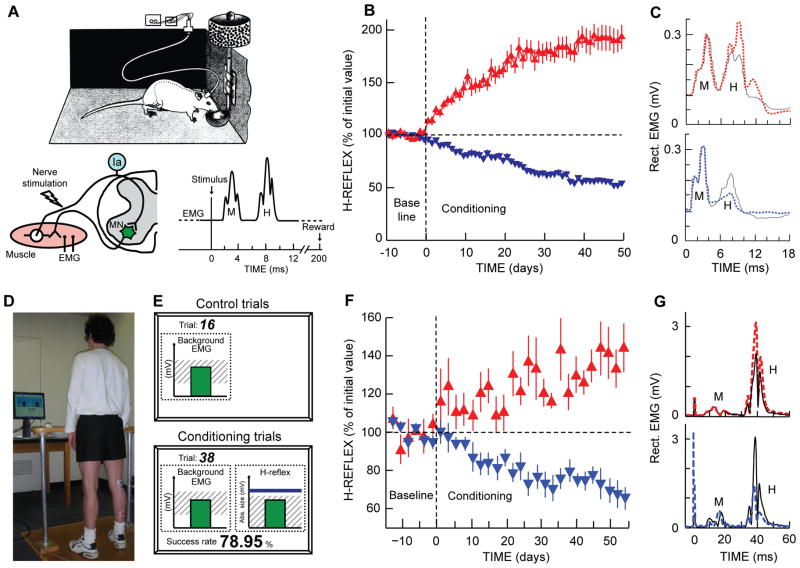Figure 2.
H-reflex operant conditioning in rats (A–C) and humans (D–G). A: The soleus H-reflex is elicited in a rat with chronically implanted EMG electrodes and a tibial nerve cuff. Whenever the absolute value of soleus EMG activity stays in a specified range for a 2.3- to 2.7-s period, tibial nerve stimulation through the cuff elicits an M-wave just above threshold and an H-reflex. For the first 10 days (from day −10 to day 0), the rat is exposed to the control mode, in which no reward occurs and the H-reflex is simply measured to determine its initial size. For the next 50 days, the rat is exposed to the up-conditioning (HRup) or down-conditioning (HRdown) mode, in which a food-pellet reward occurs 200 ms after the stimulation whenever the H-reflex is above (HRup) or below (HRdown) a criterion value. B: Average (±SEM) daily H-reflex sizes for 59 successful HRup rats (red upward triangles) and 81 successful HRdown rats (blue downward triangles). C: Average absolute value of post-stimulus EMG activity for representative days from an HRup rat (top) and an HRdown rat (bottom) in the control mode (solid) and near the end of HRup or HRdown conditioning (dashed). (Updated from (Wolpaw 1997). D–G: The subject maintains a natural standing posture and a correct level of soleus EMG activity with the aid of a visual feedback screen (D and E) that shows the current absolute value of soleus EMG activity in relation to a specified range. Whenever the absolute value of soleus EMG activity stays in this range for several sec, tibial nerve stimulation elicits an M-wave just above threshold and an H-reflex. For the first 6 sessions (i.e., baseline sessions, day −14 to day 0), the subject is exposed to the control mode, in which the H-reflex is simply measured to determine its initial size. For the next 24 sessions (i.e., conditioning sessions, days 0–56, 3 sessions/week), the subject is exposed to the HRup or HRdown conditioning mode, in which, after each conditioning trial, the screen provides immediate feedback as to whether the H-reflex was above (HRup) or below (HRdown (shown on screen)) a criterion value (E). The person completes 225 conditioning trials per session. F: Average (±SEM) daily H-reflex sizes for 6 successful HRup people (red upward triangles) and 8 successful HRdown people (blue downward triangles). G: Average peri-stimulus EMG activity from an HRup subject (top) and an HRdown subject (bottom) for a baseline session (i.e., control mode) (solid) and for the last HRup or HRdown conditioning session (dashed). (From (Thompson and others 2009a).)

